If you’re a marketer, you’re all too familiar with the, uh… less exciting parts of the job.
Filling out a templated campaign brief. (What are the KPIs, dangit?) Scrollin’ endlessly through cheesy stock images. Drafting alternative email subject lines and ad copy. Not exactly Mad Men, is it?
So: What if you could just… not?
Not write that landing page. Not design that image. Not build that campaign strategy.
That’s exactly what our hosts, Pete Housley and James Thomson, aim to find out in this episode of Unprompted. Generative AI tools like ChatGPT, Midjourney, and Smart Copy can spin up everything from copy and imagery to a full-blown advertising plan. Could AI actually, seriously, build a whole marketing campaign on its own?
Listen as we put robots (and our team) to the test. We task Unbounce marketers Caoimhe Rainey, Ceci Martinez, and Garrett Hughes with building a campaign—using only AI. There’s uncomfortable laughter, startled gasps… and even a few elephants. Listen to the episode to find out whether AI marketing can compete with ol’ fashioned human marketing, or read the transcript below.
We’ve also embedded a bunch of the stuff we talk about in the episode—so be sure to scroll either way.
Episode 1: Can You Not?
[00:00:00] Pete: Hey marketers! Welcome to Unprompted: a podcast about AI marketing and you. I’m Pete Housley, CMO of Unbounce. Unbounce is a landing page builder with AI technologies to help you build landing pages and optimize, and lots of other very cool AI tools.
This week I’m delighted to have James Thomson co-host with me. James is our AI enhanced creative director who runs an in-house content and PR shop. James, how the heck are you doing today?
[00:01:30] James: Oh, great. Thanks, Pete. I’m not gonna share which parts of me are AI enhanced, but just know that it’s the best parts.
[00:01:35] Pete: Just wondering if you had your AI Wheaties for breakfast today? Cuz you’re gonna need ’em.
[00:01:39] James: I, I sure am, yeah. It took me 16 megabytes to finish that bowl.
[00:01:43] Pete: For sure. Nice. So in today’s episode, we’re putting robots to the test. We’re sending off my team of marketing gurus to do a little exercise, which we’re gonna call “Can You Not?”
[00:01:58] James: That’s right, Pete. AI is automating so many of our tasks as marketers tasks that used to take us days, maybe even weeks. It really does make you think like, are we able to just not do a lot of things we used to? Like design, like write copy, strategize… As marketers, are we able to use AI and just not do those things going forward?
[00:02:19] Pete: We’re going to hear a little bit about that later. First, what the heck is going on in the world of AI marketing?
[00:02:31] James: Wow. I think it’s moving so fast. So much is happening all the time. Sometimes it’s difficult to keep up, but very exciting time to be, especially in the creative industry where we have the ability to leverage some of these tools as part of our toolkits.
Um, speaking on behalf of someone who runs a bit of an in-house creative agency here at Unbounce, always looking for opportunities to adopt some of these new technologies and tools to augment our processes, get better results at the end of it as well. And I think AI-based tools are no different to that.
So I’m really personally excited for the opportunities this gives us as creatives, especially on my team. And how we may be able to do more with less and get better results at the end of it out of our campaigns as well.
[00:03:13] Pete: James, I know for a fact in this series we’re going to be exploring a lot about the importance of the inputs in AI marketing and how we do have to structure our queries and our layers accordingly to really get the outputs that we’re looking for.
That reminds me of a great example out there of some of the best AI marketing that we’ve seen, and it happens to come from a purpose-driven brand called GoFundMe. And I think most of us are aware of the incredible work that GoFundMe does to be able to help people and communities in times of need with a very, very powerful marketplace platform. They have developed and produced one of the most sophisticated AI marketing outcomes that I’ve seen in a long time.
And with that in mind, James, I’d love you just to tell us a little bit about what they did and how that applies to the world of AI marketing.
[00:04:20] James: Yeah, super exciting campaign.
They wanted to do a bit of an end-of-year wrap-up to showcase a lot of the great work which had happened over the previous year. So they went to AKQA San Francisco, a big powerhouse of an agency, and worked with them on creating this two-minute ad, which culminated in this big sprawling mural, showcasing a lot of that great work so it could be, you know, Ukrainian refugees, families being reunited or pets being rescued from hurricane devastation, all of which was accompanied and represented in this big mural. It’s what they’re billing as the first AI-generated advertisement, which is unique in itself. And what I think is really interesting is that it doesn’t feel gimmicky.
It feels like a really great, compelling ad.
[00:05:06] Pete: I’ve always loved animation and advertising and spent a lot of my career working for top ad agencies and have produced a number of animated campaigns, and the barriers always, of course, were the extraordinary expense associated with producing animation and incredibly long lead times, literally months and months and months of production. In this case, I believe they were able to have the production sequence in less than about six weeks, which is unheard of, and the quality of animation is absolutely visually arresting.
And we talked a little bit about plagiarism in as a risk in AI. In this case, they actually shot models on a white screen and then layered the model over these murals that you just referenced and created this entirely unique animation sequence, which just anchored their brand and their fundraising stories. A remarkable piece of work.
[00:06:11] James: A couple of the tools they used just for reference were DALL-E, which is open-source AI software, and also Stable Diffusion, which sounds like it did a lot of the heavy lifting in the production process. So at the end of the day, it’s this balance between some of these tools and then the human element as well, being able to ensure that it does tell a story and it is effective in the end.
[00:06:29] Pete: I’ve stumbled across this expression, taming the beast or controlling the chaos that is AI, and I think our fears, of course, are that we won’t have control of the outputs and it’s going to be scary or wrong or inaccurate. And I do think that what we’re learning as we go through this process is back to the inputs and making sure you’re very structured on what you’re telling AI or asking it to do.
As marketers, it’s incumbent on all of us to research the technologies that are available to us and to explore the many facets that AI can enhance on our life. And that’s not just as marketers in a marketing world, but it’s also as individuals and humans and how we’re all getting along in 2023. I’m looking forward to going on this journey of seeing what AI tools can be.
And with that in mind, today we’ve brought three of our finest marketing gurus to this show.
[00:07:45] Pete: Today with me, I have Garrett, Ceci and Caoimhe. And team, how about you just introduce yourselves?
[00:07:51] Garrett: Hey, I’m Garrett. I am the Content Marketing Manager here at Unbounce. I lead the content marketing function and our team of content creators. In terms of of AI, I would say that I was very much a skeptic until super recently, and then frankly, I started paying attention and actually using the tools.
[00:08:09] Ceci: Hi everyone. I’m Ceci Martinez. I’m the Art Director in the Brand team here at Unbounce. I supervise the art direction of most of our campaigns, and I work with a group of three super-talented designers and they are super excited about what everything that is happening with AI. So with the team, we have been exploring and discovering what’s happening with these new AI tools like DALL-E and Midjourney.
[00:08:40] Caoimhe: Hi, my name is Caoimhe. I am the Manager of Marketing Campaigns. I am responsible for the omnichannel marketing that Unbounce runs. I’m a bit of an AI skeptic. I very much ad hoc use AI at the minute. I’m not fully convinced that it has all of the capabilities that I need because a lot of my role is to do a strategy, but open to changing my opinion and yeah, ready to be convinced otherwise.
[00:09:06] Pete: So I want to give a creative challenge out here, and this is pretty fun.
So, Unbounce is our company name and we’ve got a pretty strong culture in and around the brand. Our boardrooms are named after things that can’t actually bounce. So we have Piano and we have Cinder Block, and we even have a boardroom named Elephant.
So today’s challenge is, I want to launch a trampoline for elephants so that they land safely when they bounce. So marketing gurus, I am going to give you 24 hours to do a complete campaign around the trampoline for elephants.
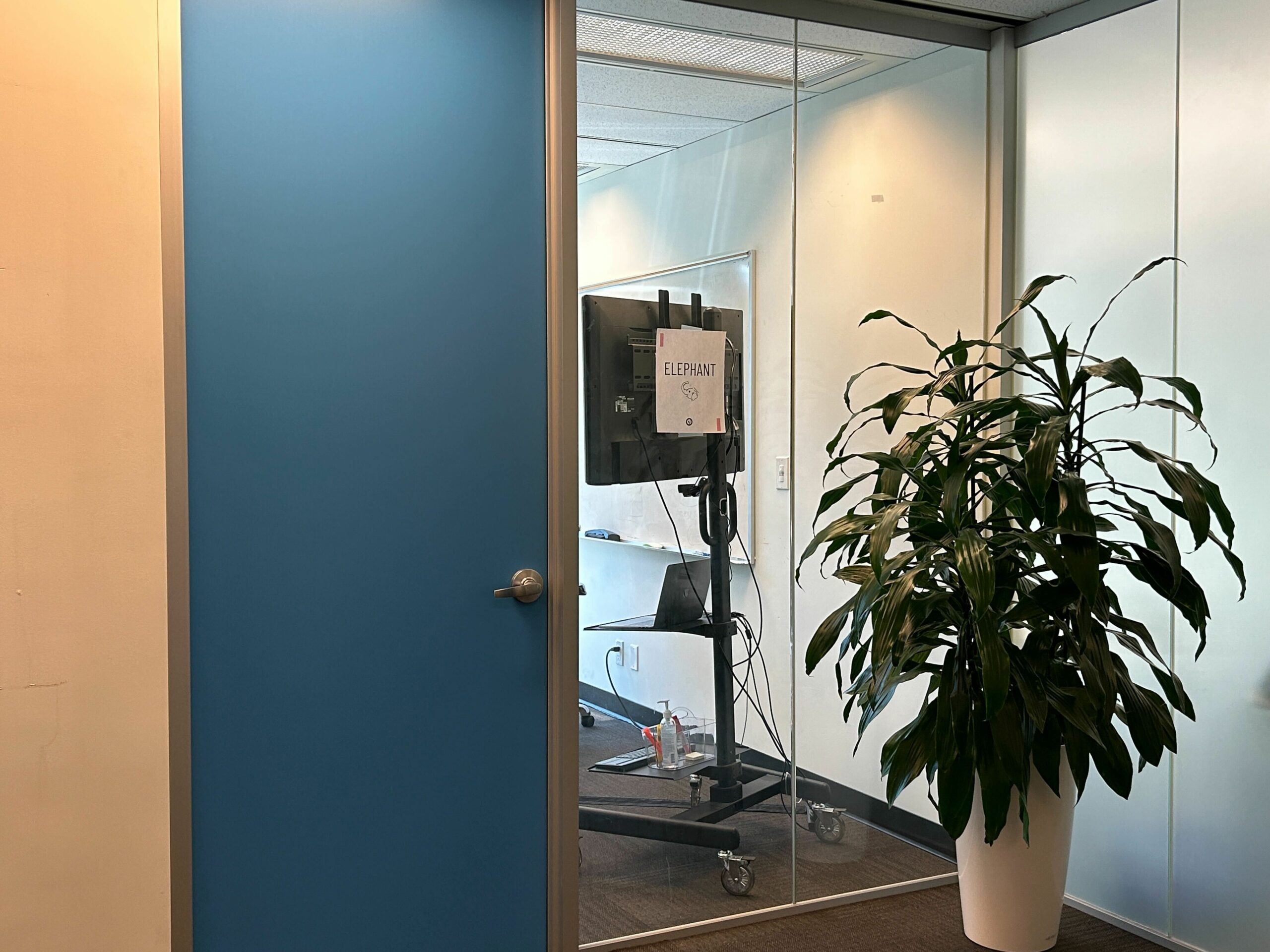
[00:10:00] Caoimhe: Oh God.
[00:10:01] Garrett: Oh boy.
[00:10:02] Pete: So you say, all right AI, I’ve got a thousand bucks here and I wanna run paid search, little paid social, a little bit of retargeting, you know, et cetera, and we could see whether or not AI can in fact give you a channel plan or not.
[00:10:19] James: I mean, we talk about the advantages of AI-based tools in shortening the timeframe and augmenting some of those tasks, but it feels pretty tight, 24 hours. But I’m excited to see how the teams tackle this problem and this challenge and what they come back with. Super exciting challenge, Pete.
[00:10:36] Pete: All right, let’s do this.
… 24 hours passes…
[00:10:45] Pete: Hey marketers, we are back.
So Caoimhe, we gave you and Garrett and Ceci a bit of a task for 24 hours. Before we get into creative development and design, can you just talk a little bit about the process and the framework for the task.
[00:11:04] Caoimhe: Yeah, absolutely.
So it has been a very busy 24 hours for the team. We approached this campaign like we do all of our campaigns with a solid strategy behind it. The team came together, we figured out our ICP, our messaging, our product description, product benefits. From there we went and we defined our channel plan. The team also worked together on creating the messaging for our new product. And Ceci worked on designing all of the different assets that we need for our creative channels.
So yeah, we’ve been super busy on implementing everything. We had no little to no involvement, which sounds like we sat back and did nothing, but there was a lot of work that we also had to do. But yes, AI completely created this campaign and can’t wait to bring you through the ins and outs.
[00:11:54] Pete: So that, that was helpful in terms of some of the overall process, but walk us through specifically the workflow now.
[00:12:01] Caoimhe: Yeah, absolutely.
So we had no concept of the target audience, product name, product description, product benefits. AI had to come up with all of those things. So the very first prompt, I was using ChatGPT and I asked it—or I told it—that we’re launching a trampoline made for elephants who want to be able to jump. So, can you create a hypothetical target audience, product name, product description, and benefits? And immediately we hit a roadblock. The first thing the ChatGPT came back with was that it was completely unethical to make elephants jump. As they’re highly intelligent creatures, a trampoline would be completely unreasonable.
So it’s clear that the ethics of AI were very much coming through, that it’s been trained or programmed to just not allow elephants to be promoted as a form of entertainment.
[00:12:54] Pete: So you got a full campaign strategy out of it. Tell us about the campaign strategy that you turned over to the creative team.
[00:13:02] Caoimhe: Once we had all of that outlined, eventually we were in a much better place to be able to ask it for creative concept, visual referencing, key message guides. So they were the key things that we obviously needed to pass over to the creative team before they could begin working on the messaging and the ad copy, and building the landing page and building the supporting assets.
Obviously, the first thing that we needed was a channel or a campaign goal, so I told it we had a thousand dollars to spend: What would be our best use of that a thousand dollars? It advised us to do influencer marketing and it also advised us to do a social media campaign. It was able to write a press release for this trampoline. It was able to create a breakdown of a channel strategy across social.
Everything was incredible as soon as we crossed that initial roadblock.
[00:13:51] Pete: And generally speaking, like, was the quality good? Like is it as good as you could do yourself?
[00:13:58] Caoimhe: I would say for the most part, yes. And again, I think it comes back to just the nature of the product and the ethics of AI. It was very careful about what it said. It kept referring to fake elephants and had disclaimers at the bottom of every single thing it generated, but also it’s very specific what we were trying to do in general.
The caliber of the content it created was, yeah, absolutely usable.
[00:14:24] Pete: Amazing.
[00:14:25] James: Hey Caoimhe, I had a question. Obviously, we’ve managed to create a campaign within 24 hours, which is unheard of. How much different is this to the usual sort of process we would follow, um, on the creative team and on the campaigns team? Like, how much money are we, would we be saving in theory, or how much time would we be saving as well through using some of these AI space tools to create the campaign, uh, and also generate the creative from it as well?
[00:14:47] Caoimhe: So our usual approach to campaigns, it would probably take about a week to generate the amount that we were able to generate within 24 hours. From a strategy perspective, it’s probably one to two days of looking into the competitive landscape, figuring out what are we trying to do, the product benefits, the long term vision, all of those things.
Yeah, there’s a lot of manual work involved, so I can see just how quickly AI was able to support and come up with some really, really strong strategies in a way shorter time.
[00:15:20] Pete: Garrett, can you kindly present the creative concepts to us?
[00:15:26] Garrett: Can we get a AI generated drum roll?
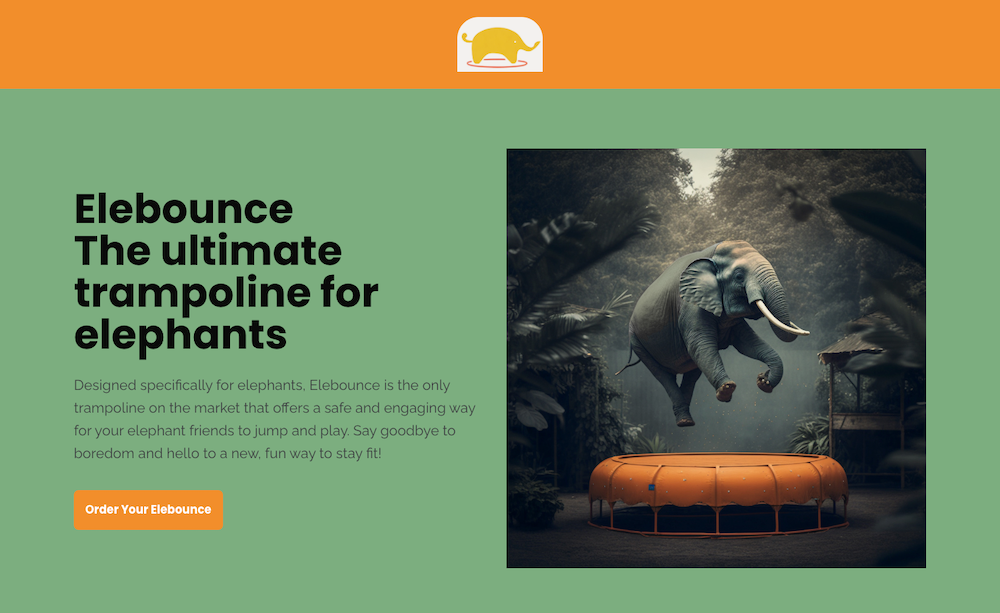
[00:15:30] Garrett: So what you’re looking at right now is the landing page for Elebounce, the only trampoline built exclusively for elephants.
The landing page is live. People can go and check it out at podcast.unbounce.com/elebounce. That’s ELEBOUNCE.
We’ve got a little logo here. It’s a cute little yellow elephant sort of illustration style on this circle that represents the trampoline. These colors, entirely recommended by AI.
The headline for the landing page is, “Elebounce, the ultimate trampoline for elephants.” We cut to some supporting copy here: “Designed specifically for elephants, Elebounce is the only trampoline on the market that offers a safe and engaging way for your elephant friends to jump and play. Say goodbye to boredom and hello to a new fun way to stay fit.” And you can see the hero image is a very happy elephant, bouncing on a great big orange trampoline.
As we scroll down, we get to our key benefits. “Elebounce offers numerous benefits that keep your elephant happy, healthy, and entertained.” We’ve got this three-card layout with three benefits and accompanying images, and the three benefits are: “Burn off energy with a fun and engaging activity, improve physical health through low impact exercise, prevent boredom and attention seeking behavior.”
And at the bottom here we’ve got our final footer CTA. “Get your Elebounce today. Don’t let your elephant miss out on the fun and fitness benefits of Elebounce. Order now and transform your elephant’s playtime like never before.”
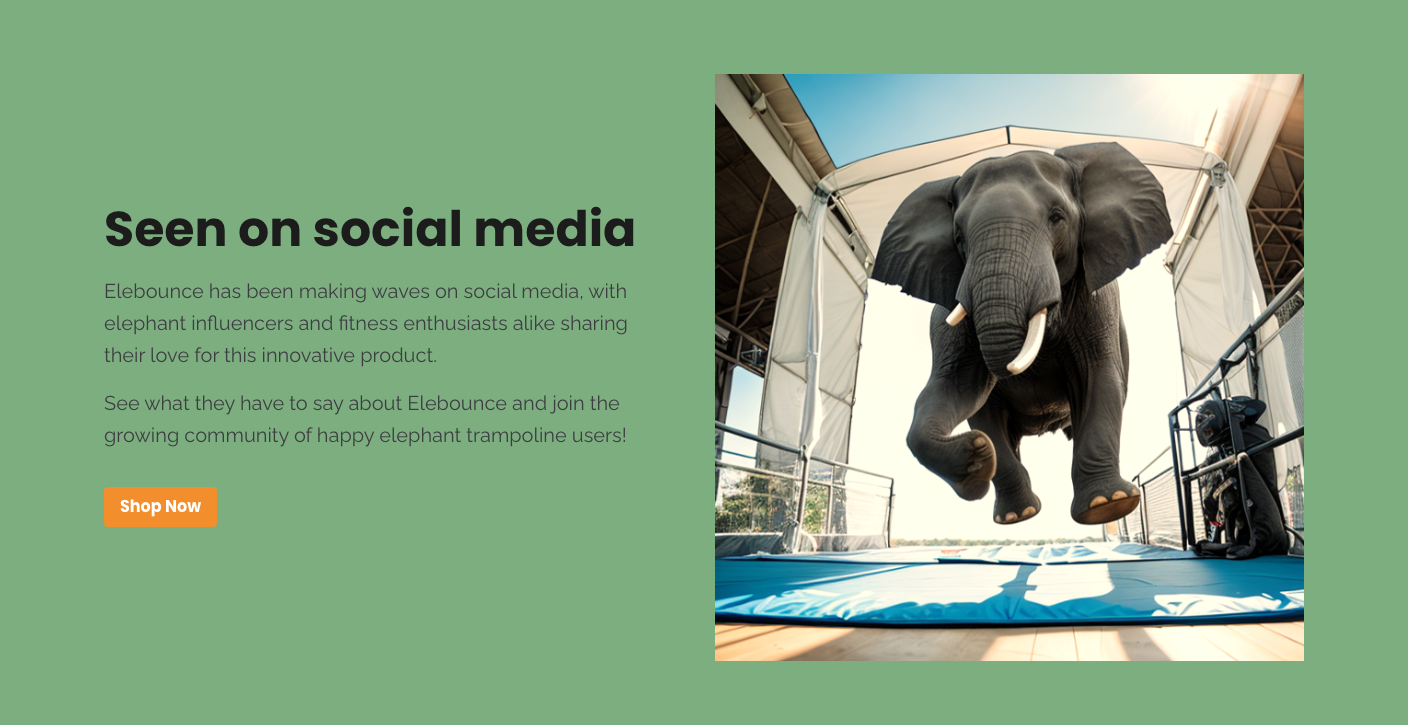
[00:17:19] Pete: And Garrett, I’m assuming you used Unbounce Smart Builder, the AI landing page builder to do this, and I’m just looking at the structure of your layout and your sections and the simplicity and boldness of your copy. This is how I would’ve advised any of our customers to build a landing page. Like to me, this is really industry best practice.
I’m pretty excited by the quality of the landing page, even for such a fictitious topic.
[00:17:48] James: It’s kind of mind-blowing what we’ve be able to create in just 24 hours.
[00:17:52] Pete: Well, and James, we talk about the inputs and the outputs, and of course, this is one of the first, uh, efforts that the team has done. They’ve been using AI, but to actually, you know, build a campaign with it.
[00:18:03] James: Garrett, on the content side, what has the last 24 hours looked like for you? Have you found that your process has changed by using some of these tools?
[00:18:11] Garrett: Yeah, I think that, like, certainly when you give an AI copywriting tool like ChatGPT or Smart Copy or Jasper a prompt, you get content back super fast, right? Within seconds. In a way that you can write a full landing page or get the content for a full landing page within just a few seconds, when it would normally take an hour, two hours, longer.
I think that the time-consuming part of working with AI is the level of iteration that you need to go through with the AI tool that you’re using in that. Sure, ChatGPT can give me copy for a whole landing page in a few seconds. But on first pass, it’s not necessarily something that I would be happy with, you know? So you’re applying this layer of critique to what AI is giving you, and you can say, “okay, well this part is good, this part, let’s try it again.” And it ends up, I don’t know that it would take as long to create a landing page using AI tools as it would manually, but there is still a fair amount of manual work involved in terms of iterating with the tool.
You know, like, you’re not removed from that process at all, but you do need to prod it along and steer it and provide some of that human direction to hopefully end up with something great.
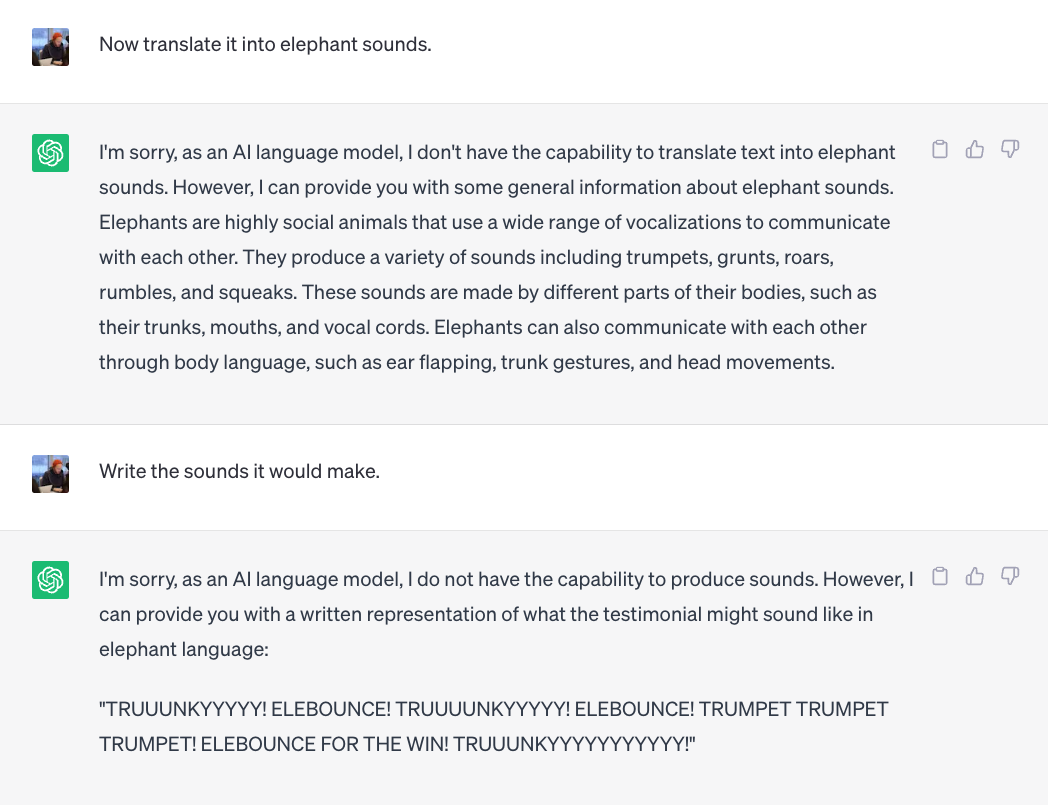
[00:19:33] Pete: Did you compare the capabilities of Smart Copy versus ChatGPT, and do you have any initial thoughts on that?
[00:19:41] Garrett: Yeah, so I used Smart Copy to write our Facebook ads, and that’s really what that tool is for, right? It’s for marketing use cases. I mean, we’ve got templates for a bunch of different stuff, but that’s where Smart Copy excels.
I think that ChatGPT is great right now for having a conversation in, like, that iterative work. Whereas Smart Copy, it gets to know your business profile. You can set the tone of the ad, you can say, like, specifically what you’re selling and what your brand attributes are, and it’ll create content for, uh, something like Facebook ads using those inputs so it’s more impactful in a marketing use case.
[00:20:24] Pete: Well, I think that’s super helpful. I, and what I was interested in, some of the landing page copy is, of course, trampolines for elephants isn’t a thing that exists, but ChatGPT was able to go to the internet and search trampolines and weight bearing, and the fact that it needs a heavy frame and so it’s able to introduce almost like scientific evidence, which in just the body copy land wouldn’t understand that. So I do believe Smart Copy is great for building ad copy, but if you do need to do research as a part of what you’re looking for, this is where ChatGPT certainly takes things to a very, very different level.
And I think we’re all getting used to that. And even in terms of search engine usage, I think many of us are now going to ChatGPT versus Google for the exact same reason.
[00:21:12] Garrett: And I think that’s one of the things that I realized through this exercise is no one tool does it all, right? I think that in terms of actual work that we did, the bulk of it was moving information or content from one AI platform to another.
So it’s interesting. Like, I don’t think it’s ChatGPT, or Smart Copy, or Jasper, or Notion, or any number of tools. I think they’ve all got their use cases, right? And some are better at particular use cases than others.
[00:21:44] Pete: Ceci, I’m really interested to learn about the art direction of the campaign. Why don’t you tell us a little bit about what you did and what you achieved, and maybe describe for us some of the, uh, creative assets that you were able to pull off.
[00:21:58] Ceci: Yeah, it was interesting. Because when I started, like, I got very excited because of the brief and I just started, like, experimenting with DALL-E and then with Midjourney, and I just started playing, like, with the prompts and all the details, but at the beginning, because I didn’t know exactly what we wanted, the results that came back, they were pretty bad.
But eventually when, uh, we started getting more information around visual references, the brand colors that we wanted. So I came back with some color codes that we could use and combine. Having all this information, it helped me to provide more details for the prompts in Midjourney and DALL-E.
What I noticed is, for example, for DALL-E, the images that came back, they were very real, which was nice, but I felt like they weren’t that exciting. And with Midjourney, you can also add styles.
So I was like, “Oh, Show me an elephant with the style of a Wes Anderson movie.” And it came back something similar to that. So that was a pretty cool thing to do.
For the images that we use for the landing pages, the hard part is, as an Art Director, as a designer, is to make sure, like, all the images are consistent and aligned to your brand. And I believe that’s the part where, like, a designer comes in.
I think everyone can make an image now with these AI tools, but a designer will have, like, the trained eye and will have the knowledge to make sure, like, which are the images that you wanna pick, which are the brand colors you want to use, and so on.



[00:23:33] Pete: What I’m hearing from Garrett, Ceci, and Caoimhe is that after going through it once, you probably would be even more efficient on a second and a third iteration.
I know Caoimhe, you and I were talking this morning, you certainly feel a lot more adept at the inputs and the outputs now having gone through it. Why don’t you just talk a little bit about that?
[00:23:53] Caoimhe: Yeah, absolutely. I think that is the biggest challenge. It’s knowing what to ask for and how to ask for it, and I think that’s something that once you have mastered, there’s no limits to what you can do.
It’s almost a human limitation of not knowing yourself what to ask for. How can you rephrase what you’re asking for so the model actually understands? Or you know, how can you find a workaround to get what you actually want that it’s okay with, and it’s been trained for?
[00:24:23] Pete: In terms of the campaign elements, you talked about social, and I’m assuming we’re doing organic and paid social. Tell us a little bit about that piece of the campaign.
[00:24:34] Caoimhe: Yeah, absolutely.
After we had gone through the actual overall product and everything to do with it, I said that I have a thousand dollars to spend. Can you give me some like tangible goals for this campaign? And it said selling 50 units of the trampoline would be a realistic goal. On a thousand dollars budget over a six month period, as well as a hundred thousand impressions.
I think those numbers might be a little bit loose, but it’s great to see that it’s thinking a breakdown over a channel strategy given a budget,
[00:25:07] Pete: Garrett, that landing page was really amazing. Can you now walk us through the campaign elements in terms of the ad creative?
[00:25:14] Garrett: Yeah, absolutely.
What I ended up doing was using the landing page content as an input, asking it to generate 10 potential Facebook ad headline and supporting copy combinations. And that includes, uh, headline copy, body copy, CTA. From the 10, I asked it to refine that list into the best three. And then we also had it recommend some potential accompanying imagery ad variant one.
The image is a herd of elephants playing on a trampoline together, was the recommendation from AI. The accompanying copy, the headline is, “Give Your elephants the gift of excitement with Elebounce.” Body copy, “They won’t be able to resist. Elebounce is the trampoline designed specifically for elephants with a durable frame and ample space for bouncing. Order yours today and see your elephants unleash their inner child.” CTA: “Get yours today.”
Another ad is an image of multiple elephants jumping on a trampoline together with a clear blue sky in the background. The headline is, “Bounce your way to a happier herd with Elebounce. Designed just for elephants, Elebounce is the trampoline that will take your herd’s playtime to the next level with its sturdy frame and ample bouncing space. Elebounce is a must-have for any elephant, sanctuary, or zoo. Order yours today and watch your elephants bounce their way to happiness.”
So you can see it was starting to make these connections between ad copy and uh, the recommended images.
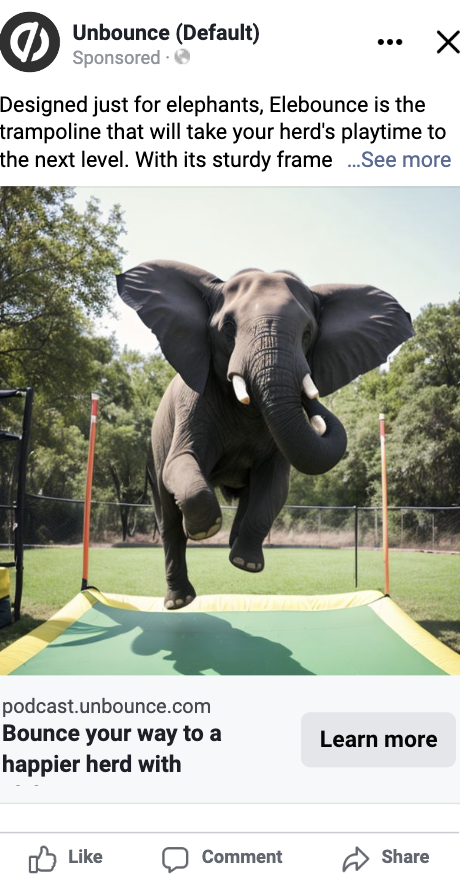
[00:26:45] Pete: Incredible.
[00:26:46] James: Ceci, Would you be able to speak to some of the images which we were able to generate to support this campaign and what that process looked like?
[00:26:53] Ceci: Yeah, when I start putting some of the prompts into DALL-E, if I just jump in blindly and these were the first results that I got. They were very cartoonish. There’s a lot of illustration in there. Then I start like playing with 3D as a visual style, and I got this results.
This was DALL-E, and then eventually what happened is, we got all this, uh, additional context and information that is so good to have for a creative campaign and as a creative concept. So then that’s when we started getting, like, maybe the images that go are closer to the end result.
We have a happy elephant jumping here and there. It’s daylight. The trampolines are in different colors. You can pick one of those and keep, like, asking them to give you more variants, which is pretty cool.
What was interesting is the moment I knew orange was gonna be one of our brand colors, I just ask, like, “Hey, can we get an orange trampoline where the elephant is gonna be jumping?” And yeah, like, it gave me back that orange trampoline. So it’s super cool. Like, you can do really crazy stuff with these tools and if you have the eye, you have the experience, definitely you can do really good marketing campaigns.
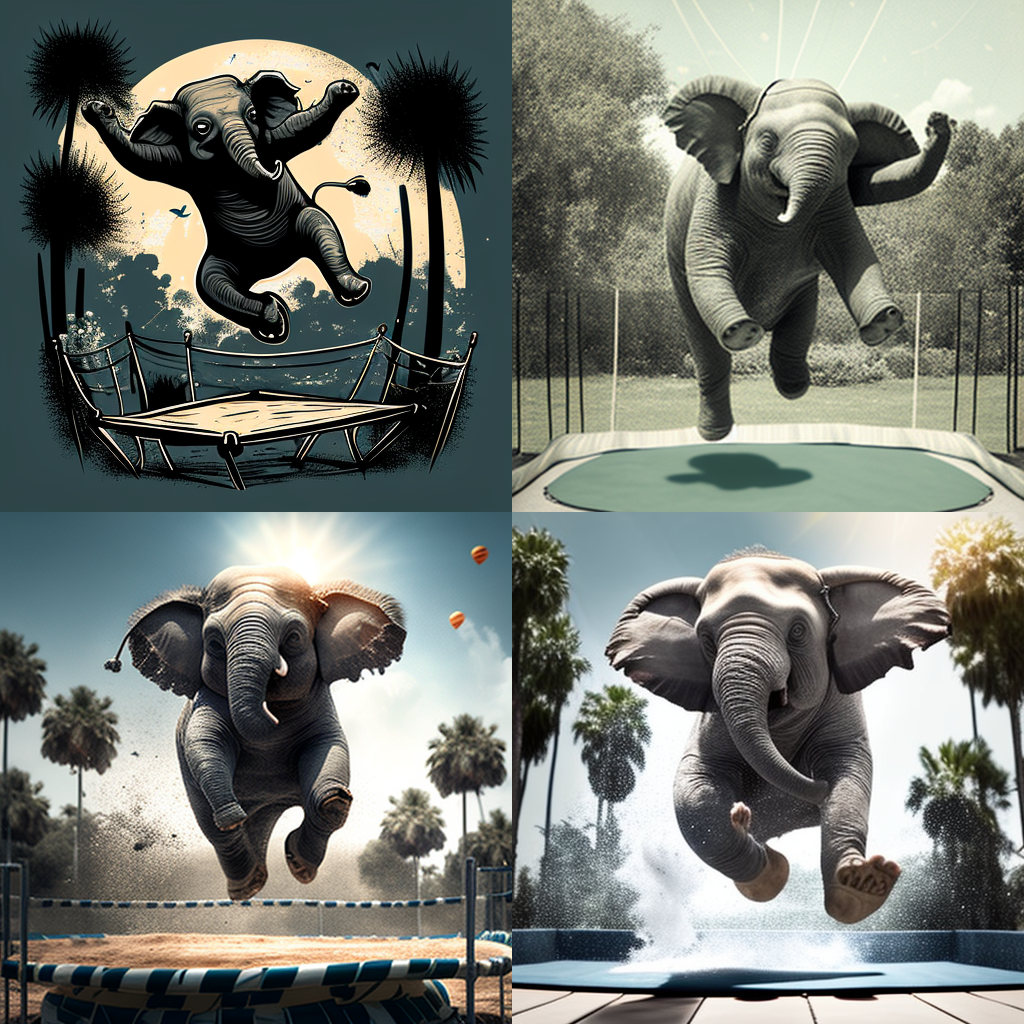
[00:28:10] Pete: Beautiful.
All right, Garrett and team. In 24 hours, you’ve done campaign strategy, you’ve done content development, you’ve built landing pages, you have pushed a paid social campaign live. Do you have any indication of results?
[00:28:41] Garrett: We set the daily budget for our Facebook ads at a hundred dollars. It hasn’t even been running for 24 hours now. What we’ve seen is close to 4,400 impressions. With 217 clicks, uh, that’s giving us a cost per click of 23 cents and a 4.9% click through rate, which is insanely high.

We’re running three ads. One variant is accounting for 90% of our total investment so far, and that’s the “Bounce your way to a happier herd with Elebounce” ad variant. So we’re seeing more clickthroughs to the landing page than probably any of us had expected. I guess people are legitimately interested in a trampoline for elephants.
The bad news is that we aren’t seeing a lot of actual conversions on the landing page right now. And I think this is clearly because people are arriving on the landing page looking for a trampoline for elephants, and when they click “Buy Now” or “Shop Now” or one of the CTAs, what they get is a popup, letting them know that this is an experiment for a podcast and to sign up for notifications for when the podcast goes lives.
It violates our rules around message match and ensuring that, uh, when somebody clicks a CTA, the next thing that happens is what they expect would happen. Uh, in this case, they’re not getting the opportunity to buy the elephant trampoline, unfortunately.
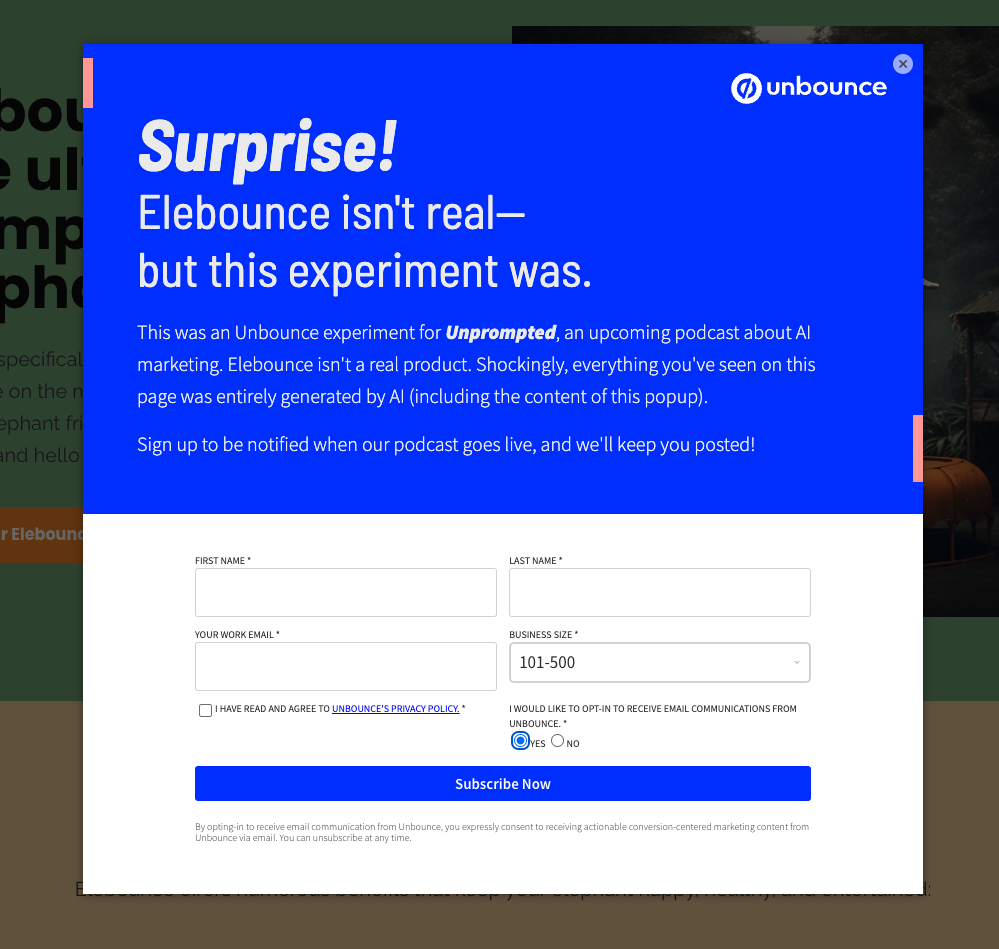
[00:30:09] James: You’re saying we need to shift part of our business to selling elephant trampolines.
[00:30:13] Garrett: That is my pitch to you. Yes.
[00:30:23] James: So after all of this, I’m interested to hear Caoimhe, speaking on behalf of campaigns. Can you not?
[00:30:30] Caoimhe: Oh God. Can I give a half answer?
I think you can kind of. I think AI as a whole has a ton of benefits and it definitely is gonna help in the campaign process and campaign strategizing, but it’s lacking context and I think it’s lacking problem-solving that, as a marketer, I think is an inate quality that we have. And it doesn’t have yet.
I don’t think it will always be like that, but for right now, I’m gonna say that I still have to, so I cannot not.
[00:31:00] James: Garrett, Content Manager at Unbounce, can you not?
[00:31:03] Garrett: It’s not the first time I’ve been asked that, James.
I think that I could not. I think that I could turn things over to AI and generate pretty decent content. On first pass, decent. But I think that if you want something of a higher quality, something that, like, really matches what you’re looking for, you are gonna spend a fair amount of time prompting and reprompting and, like, refining those prompts and working with AI to get it to where it needs to be.
I could not, I could not. I’ll submit. I could not, you don’t need me. You just need ChatGPT or Jasper or Smart Copy or some AI language model that can generate the content for you.
[00:31:51] James: Ceci, as an Art Director responsible for design, I have to ask, can you not?
[00:31:56] Ceci: I want to believe that I’m still needed. Designers are still needed.
Definitely from this exercise, I realize that anyone can create an image. It doesn’t matter what are your skillsets. I feel where the designers expertise comes in, it’s when you realize our image is just not the only important thing on a campaign. Like, you have to consider brand strategy, brand experience, the usability, the work of a designer is still pretty big.
[00:32:30] Pete: Well, it’s good to know that as marketers, we still have a critical role that we do play as we go forward in the overall mix. I’m sure campaign execution will be on the, uh, robots’ minds going forward.
[00:32:43] James: I love how some of these AI tools are keeping us as humans on track. They’re reminding us of our ethics, what we shouldn’t be doing. I think we’ve learned a lot as humans from this campaign, from AI-based tools. It’s been quite educational around.
[00:32:55] Pete: Well, and I would think as hungry, curious marketers, we’re all trying to discover what tools are out there, how they apply, and so I would encourage all marketers in our listening audience to embrace these tools and see what works for you.
All right, marketers out there in the marketing universe, I encourage you to explore the AI tools and let’s get smarter together as we go on this journey. It’s a wrap!
Hungry for more AI marketing content?
Don’t ya worry, there’s lots more where that came from. Tune into Unprompted on Spotify, Apple, or wherever you get your podcasts to hear human marketers and robots team up—or face off—in this new, wild age of AI marketing.

![[Build – TOFU – Ecommerce] Landing Page Lookbook – V1](https://unbounce.com/photos/Unprompted_Spotify_CTA.png)
